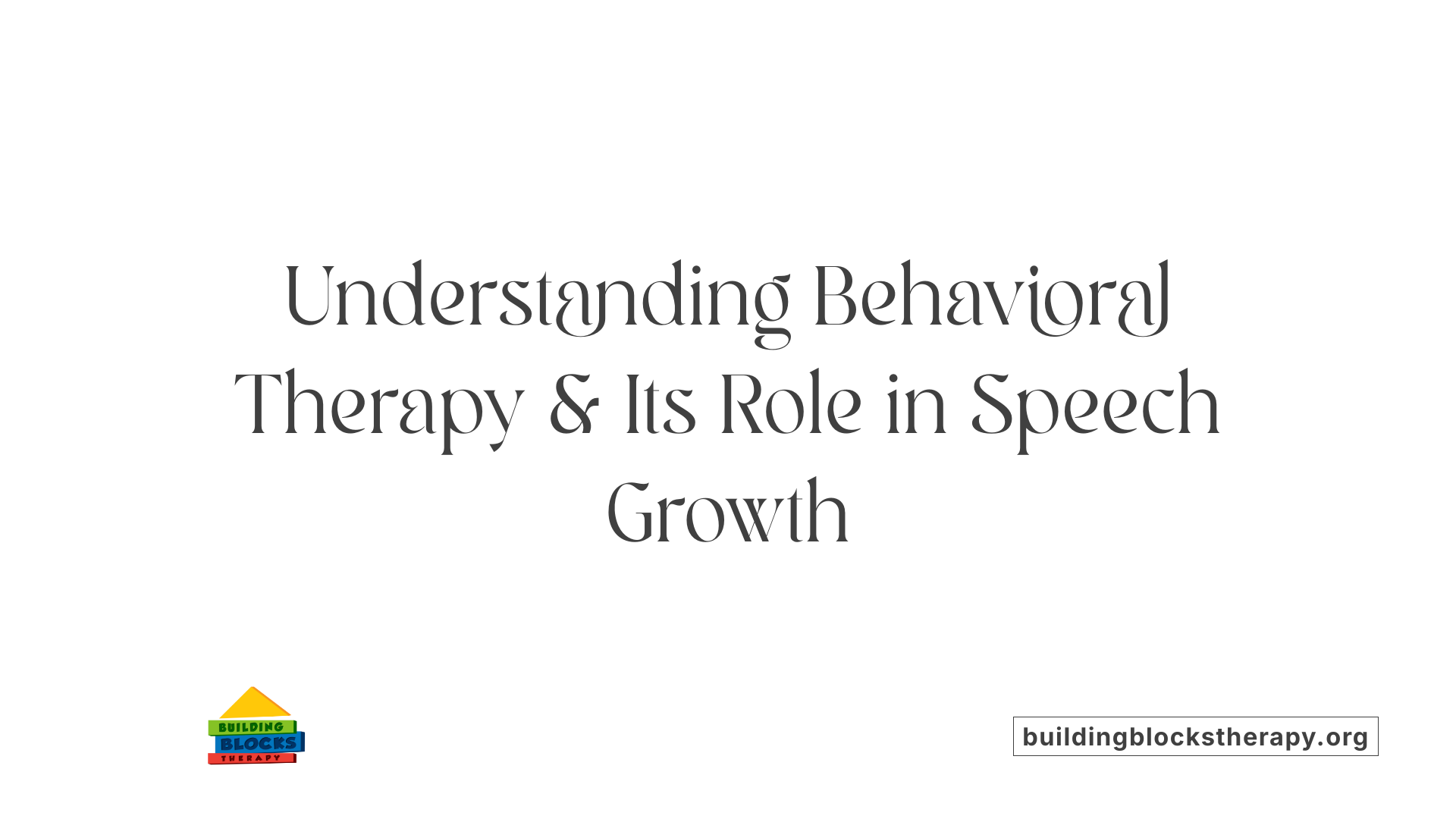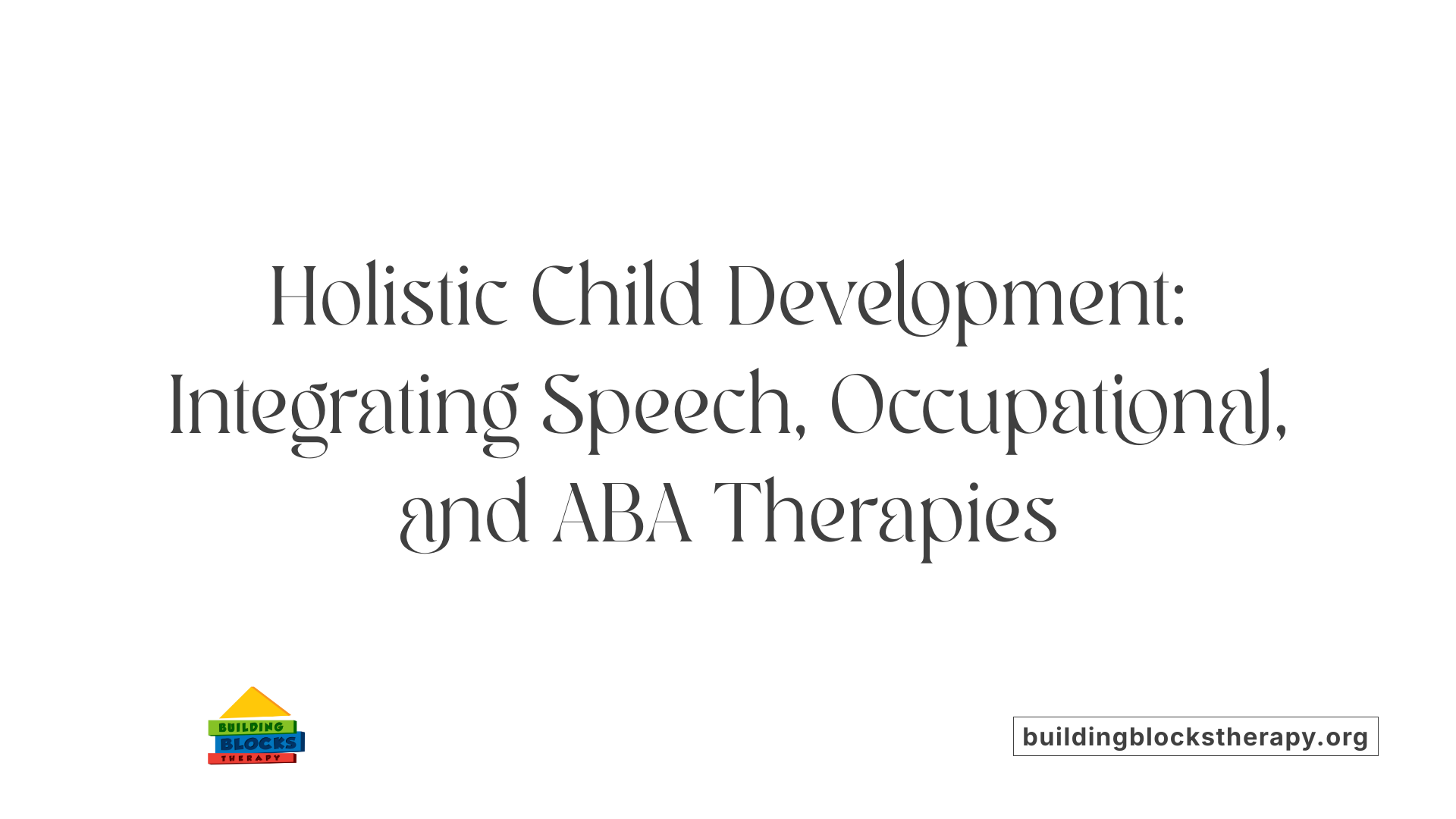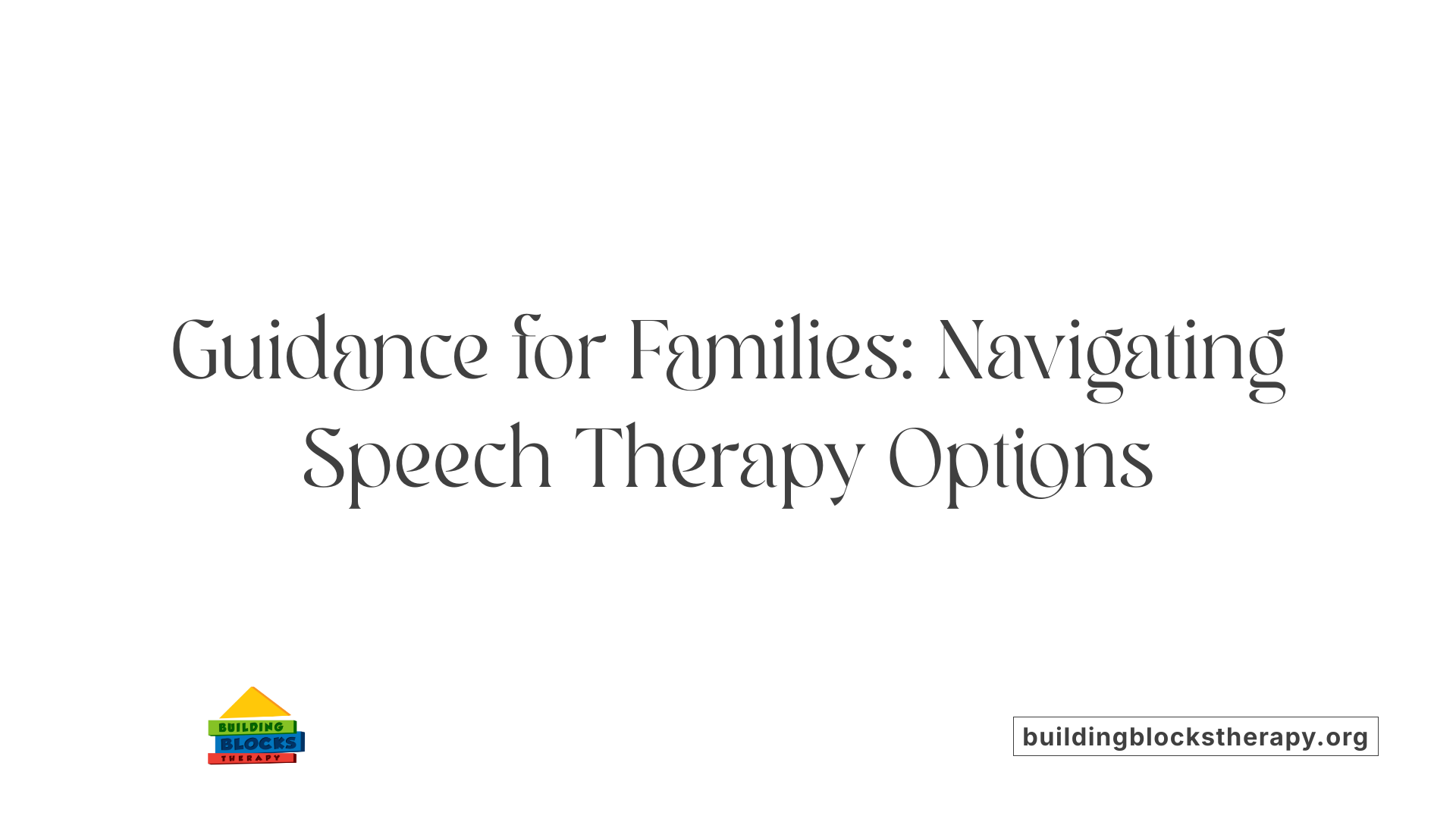The Benefits of Consistent Speech Therapy for Children with Speech Delays
Unlocking Communication Potential: The Role of Consistent Therapy in Speech Development

Understanding the Importance of Speech Consistency
Speech delays in children can profoundly impact their social interaction and learning. Consistent speech therapy offers vital support, helping children develop communication skills essential for everyday success. This article explores how consistent, interdisciplinary speech therapy—including applied behavior analysis (ABA)—facilitates significant progress for children with speech delays, particularly those on the autism spectrum, by emphasizing early intervention, structured techniques, and collaborative approaches.
What is Behavioral Therapy for Autism and its Connection to Speech Development?

What is behavioral therapy for autism?
Behavioral therapy for autism mainly refers to Applied Behavior Analysis (ABA), a scientifically supported approach that focuses on modifying behaviors to improve social, communication, and learning skills. ABA aims to encourage helpful behaviors while reducing those that interfere with learning or interaction. Techniques include breaking complex tasks into small, manageable steps, using positive reinforcement to reward desired behaviors, and closely monitoring progress to adapt therapy as needed. Different ABA methods like Pivotal Response Treatment and Discrete Trial Teaching are tailored to each child’s needs.
How does ABA use positive reinforcement and structured interventions?
ABA employs positive reinforcement by rewarding behaviors such as eye contact, turn-taking, or verbal attempts, encouraging children to repeat these actions. The therapy follows a structured, data-driven process that relies on understanding the antecedent, behavior, and consequence (the ABC model) to effectively teach and shape new skills. This approach supports consistent reinforcement across various settings and therapy disciplines, helping children generalize skills beyond therapy sessions.
How is speech therapy integrated with behavioral therapy to support communication?
Speech therapy and ABA often work together to enhance a child’s communicative functioning. ABA supports speech development by strengthening foundational skills like attention, social interaction, and gestures. Techniques such as modeling, prompting, and environmental sabotage help develop natural communication skills including commenting and giving clear instructions. Speech therapy complements these efforts by focusing more directly on language comprehension and verbal skills. This collaboration enables customized goals and strategies that address individual communication challenges.
What are the benefits of early and intensive intervention?
Starting ABA therapy early and providing intensive support—often 25-40 hours per week—can produce significant improvements in speech, social skills, and daily functioning. Research shows that early intervention helps many children with autism develop verbal communication, with some progressing to fluent speech. Combining ABA with speech and occupational therapies in a multidisciplinary approach maximizes developmental gains, addressing diverse needs and fostering long-term independence and social integration.
Who Provides Behavioral Therapy and Speech Services for Children with Autism and Speech Delays?
Types of professionals involved (BCBAs, RBTs, speech therapists, occupational therapists)
Behavioral therapy for autism is delivered by trained professionals such as Board Certified Behavior Analysts (BCBAs) and Registered Behavior Technicians (RBTs). BCBAs design and oversee individualized Applied Behavior Analysis (ABA) programs tailored to each child’s goals, while RBTs implement these programs directly with children. Speech therapists focus on improving language, communication, and social interaction skills. Occupational therapists support areas like sensory processing and daily living skills. Together, these professionals collaborate to address the multifaceted needs of children with autism and speech delays.
Settings where therapy is provided (home, school, clinic)
Therapies can be provided in several environments to best support the child’s learning and generalization of skills. Common settings include the child’s home, school, and specialized clinics. Home-based therapy offers comfort and naturalistic learning opportunities, while school settings integrate support within academic and social contexts. Clinics provide structured environments with access to specialized resources and equipment. Flexibility in setting helps maximize progress and adaptation across different environments.
Role of multidisciplinary teams
A multidisciplinary team approach is essential for comprehensive care. By combining expertise from ABA therapists, speech-language pathologists, and occupational therapists, teams develop coordinated interventions. This collaboration ensures goals address communication, social skills, behavior, and motor development holistically. The team frequently meets to review data and adjust strategies, offering responsive, individualized support that fosters long-term developmental growth.
Importance of qualified and trained therapists
Qualified and properly trained therapists ensure evidence-based methods are used effectively. BCBAs and RBTs undergo certification and ongoing education to maintain high standards in ABA therapy delivery. Speech and occupational therapists hold relevant licenses and specialized training in working with children who have autism spectrum disorder and speech delays. Families are encouraged to verify credentials and seek providers with demonstrated experience to ensure the best outcomes.
| Professional Role | Functions | Certifications/Qualifications |
|---|---|---|
| Board Certified Behavior Analyst (BCBA) | Designs and supervises ABA programs | BCBA certification requiring graduate education |
| Registered Behavior Technician (RBT) | Implements ABA therapy directly with children | RBT credential; supervised by BCBA |
| Speech Therapist | Improves language and social communication | Licensed Speech-Language Pathologist (SLP) |
| Occupational Therapist | Supports sensory, motor, and daily living skills | Licensed Occupational Therapist |
This coordinated and qualified team approach is central to effectively supporting children with autism and speech delays across various settings.
How Applied Behavior Analysis (ABA) Enhances Speech and Communication Skills

ABA techniques supporting speech development
Applied Behavior Analysis (ABA) uses several strategies to support speech growth in children, especially those with autism or speech delays. Techniques like prompting, modeling, and play help children learn important communication behaviors. ABA breaks down complex speech tasks into small, manageable steps, making it easier for children to progress steadily. For example, teaching a child to request objects may begin with eye contact and progress to verbal requests.
Use of positive reinforcement, prompting, and task breakdown
A cornerstone of ABA is positive reinforcement which rewards desired behaviors to encourage their repetition. If a child successfully imitates a sound or makes eye contact during communication, they receive praise or a preferred item. Prompting guides children toward correct responses and is gradually faded as the child gains independence. The step-by-step breakdown of speech tasks combined with reinforcement accelerates learning.
ABA’s role in improving eye contact, turn-taking, and social communication
ABA therapy highlights foundational social skills essential for verbal communication. It focuses on improving eye contact and turn-taking during interactions, which are critical skills for effective social communication. Strengthening these behaviors helps children engage more naturally in conversations and social settings, extending the benefits beyond therapy.
Data-driven assessment and individualized goal setting
ABA’s structured, data-centered approach monitors progress carefully. Qualified behavior analysts create individualized programs with specific, measurable goals based on ongoing data collection. This ensures interventions suit each child's unique learning style and needs. Regular data review allows therapists to adjust goals and reinforce skills most effectively.
How does applied behavior analysis (ABA) support individuals with autism?
ABA supports individuals with autism by increasing helpful behaviors and reducing those that interfere with learning or socialization. Through personalized strategies like reinforcement and skill modeling, it enhances communication, social interactions, and daily living skills. ABA is adaptable across home, school, and community environments, promoting meaningful developmental gains especially when started early. Its evidence-based methods, continuous assessment, and tailored interventions make it a proven, effective therapy for fostering long-term progress.
The Impact of Early and Consistent Intervention on Speech Delays

Why Is Early Diagnosis and Intervention Important?
Early diagnosis and intervention are crucial for addressing speech delays and developmental challenges effectively. Recognizing speech and language difficulties promptly allows therapeutic approaches, such as Applied Behavior Analysis (ABA) and speech therapy, to be tailored to the child's specific needs. Early intervention capitalizes on the brain’s plasticity during developmental years, providing the foundation for improved communication, cognitive, and social skills.
What Does Research Say About the Long-Term Benefits?
Scientific studies underscore the advantages of early and consistent therapy. For instance, Dawson et al. (2010) demonstrated that children with developmental delays, including speech delays and autism spectrum disorder (ASD), show significant improvements in language, cognitive, and social abilities when interventions are applied early. Intensive and sustained therapy—often 25-40 hours a week over several years—correlates with increased intellectual functioning and enhanced daily living skills.
How Does Individualized Instruction Maximize Communication Gains?
Individualized instruction is essential for maximizing outcomes in speech development. ABA programs designed by qualified behavior analysts break down complex communication skills into manageable steps, using positive reinforcement techniques such as prompting, modeling, and playing. Data-driven approaches allow professionals to adjust goals according to the child's unique learning style and progress, ensuring therapy remains responsive and effective.
What Evidence Exists on Speech Improvements in Autistic Children?
A notable 2013 study revealed that around 70% of autistic children who received early and consistent intervention attained short phrase communication, while approximately 47% progressed to fluent speech by age four or later. These findings affirm that early, evidence-based therapies can significantly enhance speech abilities even in children facing considerable communication challenges.
Integrating Speech Therapy with Other Modalities for Holistic Development

How do speech, occupational, and ABA therapies collaborate?
Speech therapy, occupational therapy, and Applied Behavior Analysis (ABA) often work together in an interdisciplinary setting to support children's holistic development. While speech therapy directly targets language skills, ABA complements this by focusing on foundational elements such as communication, attention, and social interaction. Occupational therapy addresses sensory processing and daily living skills, creating a comprehensive approach tailored to each child's needs.
How do interdisciplinary approaches target foundational skills like attention and social interaction?
ABA techniques, including positive reinforcement and task breakdown, enhance skills crucial for verbal communication—like eye contact and turn-taking. These same methods support attention span and social interactions, which speech therapy can then build upon. By jointly addressing these foundational areas, children receive coordinated, consistent strategies that foster growth across multiple domains.
How does ABA help generalize skills across environments?
ABA's structured, data-driven framework allows for consistent goal setting and progress tracking across different therapies and settings. It promotes the generalization of skills learned during therapy to natural environments by applying behavioral principles consistently. This approach encourages adaptability and helps children use communication and social skills effectively beyond clinical sessions.
In what ways does this integration enhance self-care and social abilities?
Through consistent reinforcement, ABA supports the development of self-care and social skills which extend beyond verbal communication. This benefits children in daily activities and social situations, complementing the language gains achieved in speech therapy. The collaborative approach ensures children receive holistic support tailored to their unique strengths and challenges.
Practical Considerations for Families Seeking Consistent Speech Therapy

Importance of Evaluating Qualified Local Providers
When seeking speech therapy, it is essential for families to identify qualified local providers who offer evidence-based treatments such as ABA, speech, and occupational therapies. Providers certified in disciplines like behavior analysis (BCBAs) or speech-language pathology bring specialized expertise. Early, individualized intervention leads to better outcomes, so assessing provider credentials, experience with children’s specific needs, and therapy approaches is critical.
Insurance Coverage and Navigating Payment Options
Insurance coverage for speech therapy and ABA varies widely. Many private plans and Medicaid cover medically necessary therapies, but specifics differ by policy. Families should consult medical providers to obtain necessary referrals and verify benefits with insurers early on. Understanding out-of-pocket costs and exploring funding assistance can help maintain consistent therapy without financial interruptions.
Using Diagnostic Tools Like ADOS to Guide Therapy Type
Diagnostic tools such as the Autism Diagnostic Observation Schedule (ADOS) play a key role in distinguishing conditions like autism spectrum disorder versus isolated speech delay. An accurate diagnosis helps tailor therapy plans effectively, ensuring appropriate interventions are chosen. Multidisciplinary assessments guide whether ABA, speech therapy, or combined approaches will best support a child’s development.
Tips for Maintaining Therapy Consistency and Engagement
Consistent therapy engagement is vital for long-term progress. Strategies include:
- Establishing a structured schedule that fits family routines
- Maintaining regular communication with therapists for updates and adjustments
- Encouraging practice of learned skills across daily environments to generalize abilities
- Using positive reinforcement techniques at home to motivate participation
- Collaborating with all professionals involved to ensure coordinated care
These practical steps support sustained improvement in communication, social skills, and overall development for children with speech delays and developmental needs.
Consistent Speech Therapy: A Vital Foundation for Lifelong Communication
Consistent speech therapy, particularly when integrated with behavioral approaches like ABA, plays a crucial role in supporting children with speech delays, including those on the autism spectrum. Early, individualized, and interdisciplinary interventions foster meaningful improvements in communication, social skills, and adaptive behaviors. By partnering with trained professionals and maintaining steady therapy schedules, families can enable children to develop essential speech and language abilities that shape their educational journey and quality of life. With ongoing research affirming its benefits, consistent speech therapy remains a cornerstone of effective developmental support for children facing communication challenges.
References
- Role of ABA in an Interdisciplinary Therapy Setting | Bista
- Applied Behavior Analysis (ABA)
- ABA Therapy for Speech Delay
- Speech Delay or Autism? Understanding the Signs & ...
- Behavioral Management Therapy for Autism | NICHD
- Behavioral Therapy for Autism Spectrum Disorder in ...
- Applied Behavior Analysis (ABA)
- Behavioral Therapy For Kids With Autism






